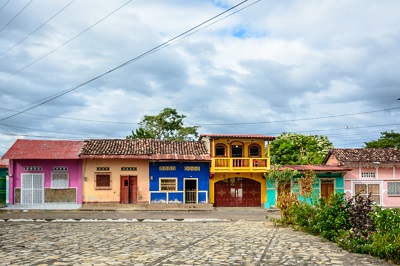 Don’t let the (often) humble exterior of typical colonial houses fool you. Only one chance to make a first impression does not apply here. What you see is what you get does not apply here either. For the real secrets of these amazing structures are hiding behind their walls. Colonial houses are not only architectural masterpieces regarding their location within the city and their exteriors but they are also architectural masterpieces regarding their interiors.
Don’t let the (often) humble exterior of typical colonial houses fool you. Only one chance to make a first impression does not apply here. What you see is what you get does not apply here either. For the real secrets of these amazing structures are hiding behind their walls. Colonial houses are not only architectural masterpieces regarding their location within the city and their exteriors but they are also architectural masterpieces regarding their interiors.
Colonial Masterpiece
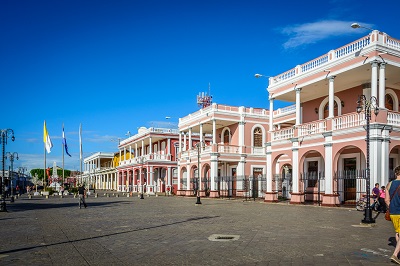 The master plan behind colonial houses (and cities) was the safety of families and their household animals (and the city itself, or maybe the other way around).
The master plan behind colonial houses (and cities) was the safety of families and their household animals (and the city itself, or maybe the other way around).
Thus, a typical colonial house is not just one house but (surprise, surprise) two; two parallel houses facing one street each, 50, 100, 200 meters away, North/South or East/West. And between the houses – the jewel of colonial living – a courtyard. The bigger the better – the bigger the courtyard the bigger the house(s). The super rich may have not two but four houses surrounding all four sides of a giant courtyard. Large or small, a courtyard is always the heart of the household. A kingdom with chilling “city walls” on the outside and steamy hot family life on the inside.
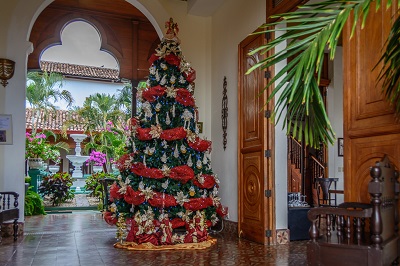 Granada, Central American colonial jewel, is undergoing a major facelift. Many of the houses have already been (beautifully) refurbished, many others are in the process of being refurbished, other ones… still in waiting. Some of them are sold to expats, some of them are turned into hostels, other ones into restaurants. Regardless of occupants and modernizations – one thing remains intact – the courtyard.
Granada, Central American colonial jewel, is undergoing a major facelift. Many of the houses have already been (beautifully) refurbished, many others are in the process of being refurbished, other ones… still in waiting. Some of them are sold to expats, some of them are turned into hostels, other ones into restaurants. Regardless of occupants and modernizations – one thing remains intact – the courtyard.
The courtyard is a center point of every colonial house, a natural place where families and friends or hostel guests gather (often by the pool these days). All restaurants, besides the sidewalk tables, have extra sittings in their courtyards for the guests who enjoy the more private setting. Family life and all household work in private residences take place in the heart of the house – in the courtyard.
(My) Colonial Living
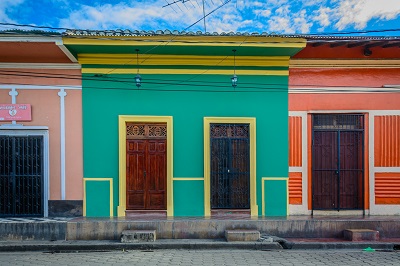 During my visit to Granada, I rented an Airbnb room in a colonial house and thereby an opportunity to glimpse into colonial living which was both fascinating and very educational.
During my visit to Granada, I rented an Airbnb room in a colonial house and thereby an opportunity to glimpse into colonial living which was both fascinating and very educational.
There were only three people in my house; my host – a guy of maybe 35, his mother and the mother’s sister. Their house (the green one), other than the fresh paint, doesn’t look much for the world, does it? But once you enter it…
Colonial Interiors (the first house)
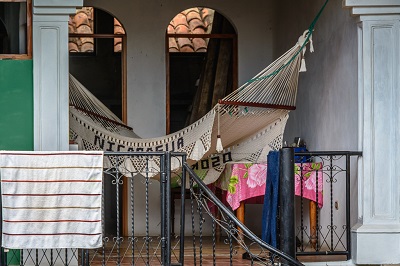 Once you enter a colonial house, you typically come directly into a large room (which could be turned into a shop or some other business today), followed by another large room(s) and/or dining room, tv-room. They just come, one after another. The larger house the more rooms. The kitchen is at the end, right at the back of the house. Then comes the courtyard. There are no doors between the rooms. In larger houses, there may also be a couple of other smaller rooms, with doors, (former maids quarters?) handy today as extra bedrooms. Master bedroom along with one or two or more extra (bed)rooms are upstairs. Behind a lovely and breezy deck with a hammock facing the yard. Hammocks can be found everywhere; on decks, landings, courtyards and even inside rooms.
Once you enter a colonial house, you typically come directly into a large room (which could be turned into a shop or some other business today), followed by another large room(s) and/or dining room, tv-room. They just come, one after another. The larger house the more rooms. The kitchen is at the end, right at the back of the house. Then comes the courtyard. There are no doors between the rooms. In larger houses, there may also be a couple of other smaller rooms, with doors, (former maids quarters?) handy today as extra bedrooms. Master bedroom along with one or two or more extra (bed)rooms are upstairs. Behind a lovely and breezy deck with a hammock facing the yard. Hammocks can be found everywhere; on decks, landings, courtyards and even inside rooms.
Colonial Courtyard
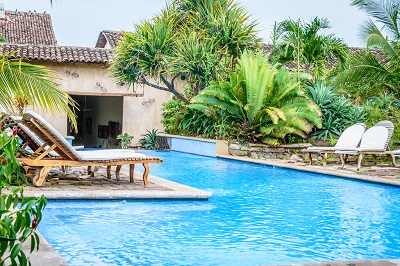 Once you enter the courtyard you also enter another world. There are trees, flowers, garden furniture for family gatherings, a playground for kids, maybe even a pool. There is also another kitchen with BBQ, laundry facility, open air dryer, bathroom, store rum and whatever else a family may need. In refurbished houses, people install extra bathrooms inside and a pool in the courtyards.
Once you enter the courtyard you also enter another world. There are trees, flowers, garden furniture for family gatherings, a playground for kids, maybe even a pool. There is also another kitchen with BBQ, laundry facility, open air dryer, bathroom, store rum and whatever else a family may need. In refurbished houses, people install extra bathrooms inside and a pool in the courtyards.
The courtyard is a center of all activities. Work and pleasure.
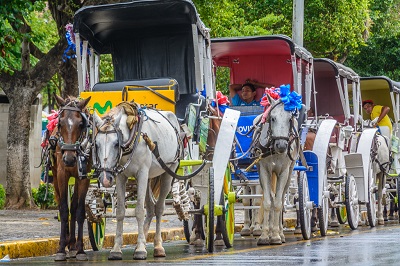 The master planners seemed to have thought about everything incl sanitation. Not to jeopardize families’ health the courtyards were big, as big as only possible. Families used to keep household animals incl horses in their courtyards – some may still do it even today. There is no shortage of horses in Granada. Some of them ‘work’ for the tourist industry but most of them are mere means of transportation for families and goods.
The master planners seemed to have thought about everything incl sanitation. Not to jeopardize families’ health the courtyards were big, as big as only possible. Families used to keep household animals incl horses in their courtyards – some may still do it even today. There is no shortage of horses in Granada. Some of them ‘work’ for the tourist industry but most of them are mere means of transportation for families and goods.
When I arrived there were three hens in ‘my’ courtyard but vanished later. I guess they were all part of Christmas dinner.
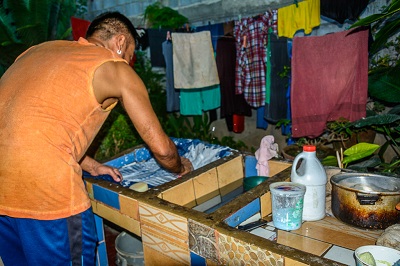 My host family didn’t use the indoor kitchen. Not for the cooking. Most of the cooking took place in the courtyard above an open fire. Slow cook camping style. But what surprised me (rather amused) the most was the washing facilities.
My host family didn’t use the indoor kitchen. Not for the cooking. Most of the cooking took place in the courtyard above an open fire. Slow cook camping style. But what surprised me (rather amused) the most was the washing facilities.
Another surprise was the host himself and my stereotyped way of looking at Latino men and their mothers. Well, in this household it wasn’t the mother (or aunt) who did daily chores for their only son/nephew. It was “the baby of the house’ himself who did all his own cleaning (incl Airbnb room), cooking, and laundry, all that besides a full-time job and four-hour commute. A week of laundry takes two hours to wash. Yet he didn’t think there was any need for a washing machine as the current facility (which was just replaced) works way better.
The (secret) Second House
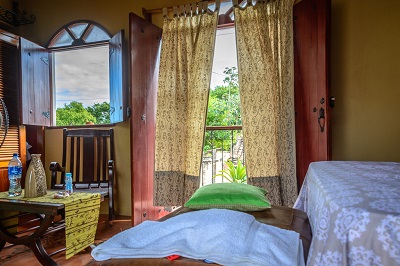 The second house is very much a copy of the first one but (often) smaller. I lived in “the second house”. There was only one large bedroom upstairs, no deck with a hammock but a longish landing facing the courtyard and a small balcony facing the other street and (best of all) an en-suite bathroom. Three windows and two doors supplied all the fresh air I needed, and some. A narrow, not more than 50 cm wide spiral flight of stairs connected courtyard with the upstairs.
The second house is very much a copy of the first one but (often) smaller. I lived in “the second house”. There was only one large bedroom upstairs, no deck with a hammock but a longish landing facing the courtyard and a small balcony facing the other street and (best of all) an en-suite bathroom. Three windows and two doors supplied all the fresh air I needed, and some. A narrow, not more than 50 cm wide spiral flight of stairs connected courtyard with the upstairs.
The furniture in my room was typical Nicaraguan – wooden chairs and wooden coffee table. Exactly the same furniture you’ll find in every Nicaraguan home. (You’ve seen one you’ve seen them all.)
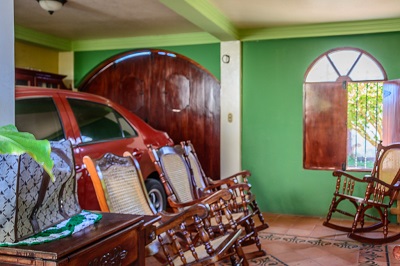
The living room downstairs was partially my host’s mother’s own tv room and partially… a garage. Doors to the house were large so there was no problem driving the car into the house. Great strategic planning lies behind those large gate-like doors – logistics – to connect the two streets. To make a passage for horses. This is why there are no doors between the rooms. No doors, no hinder for the horses to make a crossing to the other side.
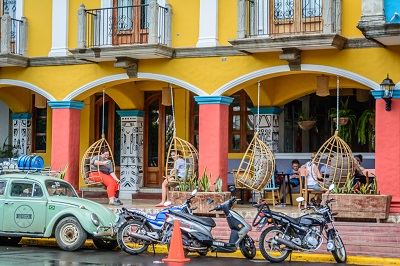 Only luxury hotels have air con. Family homes in Nicaragua and Costa Rica and probably in the whole of Central America use fans. Most of the households, incl hotels/hostels, don’t have hot water. My first encounter with lack of hot water happened in ‘my’ colonial house. What can I say? Not a fan. Another thing I was missing, which is also seldom used in this part of the world, was window/door screen. To keep the few bugs out I had to close all doors and windows at night (5 p,m, ish) and turn on the fan rather than let the natural cool breeze in which would be so much more economical and so much nicer.
Only luxury hotels have air con. Family homes in Nicaragua and Costa Rica and probably in the whole of Central America use fans. Most of the households, incl hotels/hostels, don’t have hot water. My first encounter with lack of hot water happened in ‘my’ colonial house. What can I say? Not a fan. Another thing I was missing, which is also seldom used in this part of the world, was window/door screen. To keep the few bugs out I had to close all doors and windows at night (5 p,m, ish) and turn on the fan rather than let the natural cool breeze in which would be so much more economical and so much nicer.
Colonial Breeze
Breeze. It is all about letting the cool breeze in. The brilliant construction of the houses helps maximize ventilation by letting the fresh breeze in from both North and South or East and West. The breeziest place in the house seems to be right by the front door. It is where families love to gather. The still better place is right outside on the pavement/steps in front of the house, especially in smaller houses I took a while to understand why would anybody like to sit there. And once again the masterminds of colonial construction proved their brilliance – for once you step outside you’ll get the breeze not only from North/South but also from East/West.
p.s. Happy New Year





Pingback: La Antigua > One way ticket to Panama